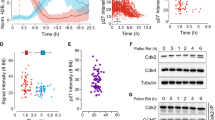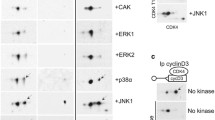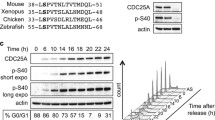Abstract
The current textbook dogma of G1 cell cycle progression proposes that cyclin D-Cdk4/Cdk6 inactivates the pRb tumor suppressor during early G1 phase by progressive multi-phosphorylation, termed hypo-phosphorylation, to release E2F transcription factors that specifically turn on the cyclin E gene, which then activate Cdk2 and complete pRb’s inactivation by hyper-phosphorylation at the restriction point. However, this model has remained largely untested from a biochemical standpoint for more than 20 years. Moreover, the biologically active form(s) of pRb present during early G1 phase is uncharacterized, and a precise understanding of a potential “pRb phospho-code,” regulating association with individual pRb partners, remains elusive. Recently, using quantitative 2D isoelectric focusing (2D IEF) to directly count phosphates on pRb, we have shown pRb to be exclusively mono-phosphorylated in early G1 phase by cyclin D-Cdk4/Cdk6 complexes acting to modify only one of each of the 14 Cdk phosphorylation sites per individual pRb molecule. Mono-phosphorylated pRb is functionally active in early G1 phase and binds to and represses E2Fs as well as the E1a oncoprotein. Biologically, cells undergoing a DNA damage response activate cyclin D-Cdk4/Cdk6 to generate mono-phosphorylated pRb to regulate global transcription, whereas un-phosphorylated pRb is inactive during a DNA damage response. At the late G1 restriction point, activation of cyclin E-Cdk2 complexes inactivates pRb by quantum hyper-phosphorylation. These observations fundamentally change our understanding of G1 cell cycle progression and show that mono-phosphorylated pRb, generated by cyclin D-Cdk4/Cdk6, is the biologically active pRb isoform in early G1 phase that represses E2F transcription and that cyclin E-Cdk2 is the pRb inactivating kinase. These findings raise clear questions about the role of cyclin D1 as an oncogene and about the cellular state elicited by drugs targeting cyclin D1’s partner kinases, Cdk4 and Cdk6. Herein, we summarize the findings leading to this paradigm shift and offer a hypothesis reconciling the apparently contradictory roles of cyclin D-Cdk4/Cdk6 as pRb activator and as a common oncogenic driver.
Access this chapter
Tax calculation will be finalised at checkout
Purchases are for personal use only
Similar content being viewed by others
References
Adams PD, Li X, Sellers WR, Baker KB, Leng X, Harper JW, Taya Y, Kaelin WG. Retinoblastoma protein contains a C-terminal motif that targets it for phosphorylation by cyclin-cdk complexes. Mol Cell Biol. 1999;19:1068–80.
Avni D, Yang H, Martelli F, Hofmann F, ElShamy WM, Ganesan S, Scully R, Livingston DM. Active localization of the retinoblastoma protein in chromatin and its response to S phase DNA damage. Mol Cell. 2003;12:735–46.
Brugarolas J, Moberg K, Boyd SD, Taya Y, Jacks T, Lees JA. Inhibition of cyclin-dependent kinase 2 by p21 is necessary for retinoblastoma protein-mediated G1 arrest after gamma-irradiation. Proc Natl Acad Sci U S A. 1999;96:1002–7.
Burke JR, Hura GL, Rubin SM. Structures of inactive retinoblastoma protein reveal multiple mechanisms for cell cycle control. Genes Dev. 2012;26:1156–66.
Burkhart DL, Sage J. Cellular mechanisms of tumour suppression by the retinoblastoma gene. Nat Rev Cancer. 2008;8:671–82.
Chen PL, Scully P, Shew JY, Wang JY, Lee WH. Phosphorylation of the retinoblastoma gene product is modulated during the cell cycle and cellular differentiation. Cell. 1989;58:1193–8.
Choi YJ, Anders L. Signaling through cyclin D-dependent kinases. Oncogene. 2014;33:1890–903.
Dowdy SF, Hinds PW, Louie K, Reed SI, Arnold A, Weinberg RA. Physical interaction of the retinoblastoma protein with human D cyclins. Cell. 1993;73:499–511.
Ewen ME, Sluss HK, Sherr CJ, Matsushime H, Kato J, Livingston DM. Functional interactions of the retinoblastoma protein with mammalian D-type cyclins. Cell. 1993;73:487–97.
Ezhevsky SA, Nagahara H, Vocero-Akbani AM, Gius DR, Wei MC, Dowdy SF. Hypo-phosphorylation of the retinoblastoma protein (pRb) by cyclin D:Cdk4/6 complexes results in active pRb. Proc Natl Acad Sci U S A. 1997;94:10699–704.
Ezhevsky SA, Ho A, Becker-Hapak M, Davis PK, Dowdy SF. Differential regulation of retinoblastoma tumor suppressor protein by G(1) cyclin-dependent kinase complexes in vivo. Mol Cell Biol. 2001;21:4773–84.
Gius D, Ezhevsky SA, Becker-Hapak M, Nagahara H, Wei MC, Dowdy SF. Transduced p16INK4a Peptides Inhibit Hypo-Phosphorylation of the Retinoblastoma Protein and Cell Cycle Progression Prior to Activation of Cdk2 Complexes in Late G1. Cancer Res. 1999;59:2577–80.
Haberichter T, Madge BR, Christopher RA, Yoshioka N, Dhiman A, Miller R, Gendelman R, Aksenov SV, Khalil IG, Dowdy SF. A systems biology dynamical model of mammalian G1 cell cycle progression. Mol Syst Biol. 2007;3:84–92.
Harrington EA, Bruce JL, Harlow E, Dyson N. pRB plays an essential role in cell cycle arrest induced by DNA damage. Proc Natl Acad Sci U S A. 1998;95:11945–50.
Henley SA, Dick FA. The retinoblastoma family of proteins and their regulatory functions in the mammalian cell division cycle. Cell Div. 2012;7:10.
Hinds PW, Mittnacht S, Dulic V, Arnold A, Reed SI, Weinberg RA. Regulation of retinoblastoma protein functions by ectopic expression of human cyclins. Cell. 1992;70:993–1006.
Ho A, Dowdy SF. Regulation of G(1) cell-cycle progression by oncogenes and tumor suppressor genes. Curr Opin Genet Dev. 2002;12:47–52.
Johnson A, Skotheim JM. Start and the restriction point. Curr Opin Cell Biol. 2013;25:717–23.
Knudsen ES, Wang JY. Dual mechanisms for the inhibition of E2F binding to RB by cyclin-dependent kinase-mediated RB phosphorylation. Mol Cell Biol. 1997;17:5771–83.
Knudsen KE, Booth D, Naderi S, Sever-Chroneos Z, Fribourg AF, Hunton IC, Feramisco JR, Wang JY, Knudsen ES. RB-dependent S-phase response to DNA damage. Mol Cell Biol. 2000;20:7751–63.
Knudsen ES, Knudsen KE. Retinoblastoma tumor suppressor: where cancer meets the cell cycle. Exp Biol Med. 2006;231:1271–8.
Lamber EP, Beuron F, Morris EP, Svergun DI, Mittnacht S. Structural insights into the mechanism of phosphoregulation of the retinoblastoma protein. PLoS One. 2013;8:e58463.
Lee WH, Shew JY, Hong FD, Sery TW, Donoso LA, Young LJ, Bookstein R, Lee EY. The retinoblastoma susceptibility gene encodes a nuclear phosphoprotein associated with DNA binding activity. Nature. 1987;329:642–5.
Lee JO, Russo AA, Pavletich NP. Structure of the retinoblastoma tumour-suppressor pocket domain bound to a peptide from HPV E7. Nature. 1998;391:859–65.
Leng X, Connell-Crowley L, Goodrich D, Harper JW. S-Phase entry upon ectopic expression of G1 cyclin-dependent kinases in the absence of retinoblastoma protein phosphorylation. Curr Biol. 1997;7:709–12.
Ludlow JW, DeCaprio JA, Huang CM, Lee WH, Paucha E, Livingston DM. SV40 large T antigen binds preferentially to an underphosphorylated member of the retinoblastoma susceptibility gene product family. Cell. 1989;56:57–65.
Lundberg AS, Weinberg RA. Functional inactivation of the retinoblastoma protein requires sequential modification by at least two distinct cyclin-cdk complexes. Mol Cell Biol. 1998;18:753–61.
Mittnacht S, Lees JA, Desai D, Harlow E, Morgan DO, Weinberg RA. Distinct sub-populations of the retinoblastoma protein show a distinct pattern of phosphorylation. EMBO J. 1994;13:118–27.
Morris EJ, Dyson NJ. Retinoblastoma protein partners. Adv Cancer Res. 2001;82:1–54.
Nagahara H, Ezhevsky SA, Vocero-Akbani A, Kaldis P, Solomon MJ, Dowdy SF. TGF-ß targeted inactivation of cyclin E:Cdk2 complexes by inhibition of Cdk2 activating kinase activity. Proc Natl Acad Sci U S A. 1999;96:14961–6.
Narasimha AM, Kaulich M, Shapiro GS, Choi YJ, Sicinski P, Dowdy SF. Cyclin D activates the Rb tumor suppressor by Mono-phosphorylation. elife. 2014. doi:10.7554/eLife.02872.
Pardee AB. A restriction point for control of normal animal cell proliferation. Proc Natl Acad Sci U S A. 1974;71:1286–90.
Paternot S, Bockstaele L, Bisteau X, Kooken H, Coulonval K, Roger PP. Rb inactivation in cell cycle and cancer: the puzzle of highly regulated activating phosphorylation of CDK4 versus constitutively active CDK-activating kinase. Cell Cycle. 2010;9:689–99.
Resnitzky D, Gossen M, Bujard H, Reed SI. Acceleration of the G1/S phase transition by expression of cyclins D1 and E with an inducible system. Mol Cell Biol. 1994;14:1669–79.
Sherr CJ. G1 phase progression: cycling on cue. Cell. 1994;79:551–5.
Sherr CJ, McCormick F. The RB and p53 pathways in cancer. Cancer Cell. 2002;2:103–12.
Sherr CJ, Beach D, Shapiro GI. Targeting CDK4 and CDK6: from discovery to therapy. Cancer Discov. 2016;6:353–67.
Yu B, Becker-Hapak M, Snyder EL, Vooijs M, Denicourt C, Dowdy SF. Distinct and non-overlapping roles for pRB and cyclin D:Cdk4/6 activity in Melanocyte survival. Proc Natl Acad Sci U S A. 2003;100:14881–6.
Author information
Authors and Affiliations
Corresponding author
Editor information
Editors and Affiliations
Rights and permissions
Copyright information
© 2018 Springer International Publishing AG
About this chapter
Cite this chapter
Dowdy, S.F. (2018). Death of a Dogma: Cyclin D Activates Rb by Mono-phosphorylation. In: Hinds, P., Brown, N. (eds) D-type Cyclins and Cancer. Current Cancer Research. Springer, Cham. https://doi.org/10.1007/978-3-319-64451-6_6
Download citation
DOI: https://doi.org/10.1007/978-3-319-64451-6_6
Published:
Publisher Name: Springer, Cham
Print ISBN: 978-3-319-64449-3
Online ISBN: 978-3-319-64451-6
eBook Packages: MedicineMedicine (R0)




